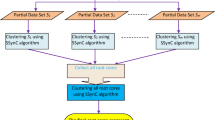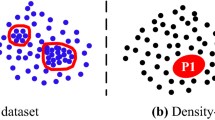Abstract
This paper presents an Effective Synchronization Clustering (ESynC) algorithm using a linear version of Vicsek model. The development of ESynC algorithm is inspired by Synchronization Clustering (SynC) algorithm and Vicsek model. After some analysis and experimental comparison, we observe that ESynC algorithm based on the linear version of Vicsek model can get better local synchronization effect than SynC algorithm based on an extensive Kuramoto model and a similar synchronization clustering algorithm based on the original version of Vicsek model. By some simulated experiments of some artificial data sets, eight UCI data sets, and three picture data sets, we observe that ESynC algorithm not only gets better local synchronization effect but also needs less iterative times and time cost than SynC algorithm. We also introduce an Improved ESynC algorithm (IESynC algorithm) in time cost by combining multidimensional grid partitioning method and Red-Black tree structure. By some simulated experiments, we observe that IESynC algorithm can get some improvement of time cost than ESynC algorithm in some data sets. Extensive comparison experiments with some class clustering algorithms demonstrate that our two algorithms can often get acceptable clustering results in many cases. At last, it gives several solid and insightful future research suggestions.








Similar content being viewed by others
References
Agrawal R, Gehrke J, Gunopolos D et al (1998) Automatic subspace clustering of high dimensional data for data mining application. In: Proceedings of ACM SIGMOD, pp 94–105
Ankerst M, Breunig MM, Kriegel HP, Sander J (1999) OPTICS: Ordering points to identify the clustering structure. In: Proceedings of ACM SIGMOD, pp 49–60
Bezdek JC (1981) Pattern recognition with fuzzy objective function algorithms. Plenum Press, New York
Böhm C, Plant C, Shao J, et al. (2010) Clustering by synchronization. In: Proceedings of ACM SIGKDD. USA, Washington, pp 583–592
Chen X (2013) Clustering based on a near neighbor graph and a grid cell graph. J Intell Inf Syst 40(3):529–554
Chen X (2014) A fast synchronization clustering algorithm. arXiv:1407.7449 [cs.LG].
Chen X (2015) A new clustering algorithm based on near neighbor influence. Expert Syst Appl 42(21):7746–7758
Chen Z, Zhang HT, Chen X, Chen D, Zhou T (2015) Two-level leader-follower organization in pigeon flocks. Eur phys Lett 112(2):20008
Comaniciu D, Meer P (2002) Mean shift: a robust approach toward feature space analysis. IEEE T Pattern Anal 24(5):603–619
Czirok A, Barabasi AL, Vicsek T (1999) Collective motion of self-propelled particles: kinetic phase transition in one dimension. Phys Rev Lett 82:209–212
Ester M, Kriegel HP, Sander J, Xu X (1996) A density-based algorithm for discovering clusters in large spatial data sets with noise. In: Proceedings of the 2-th International Conference on Knowledge Discovery and Data Mining, pp 226–231
Frank A (2010) Asuncion a. UCI Machine Learning Repository Irvine, University of California
Frey BJ, Dueck D (2007) Clustering by passing messages between data points. Science 315(1):972–976
Fukunaga K, Hostetler L (1975) The estimation of the gradient of a density function, with applications in pattern recognition. IEEE T Inform Theory 21(1):32–40
Gräunwald P (2005) A tutorial introduction to the minimum description length principle. MIT Press, Cambridge
Guha S, Rastogi R, Shim K (2001) Cure: an efficient clustering algorithm for large databases. Inform Syst 26(1):35–58
Horn D, Gottlieb A (2002) Algorithm for data clustering in pattern recognition problems based on quantum mechanics. Phys Rev Lett 88(1):018702
Huang JB, Kang JM, Qi JJ, Sun HL (2013) A hierarchical clustering method based on a dynamic synchronization model. Sci China Ser F: Inform Sci 43:599–610
Jadbabaie A, Lin J, Morse AS (2003) Coordination of groups of mobile autonomous agents using nearest neighbor rules. IEEE T Automat Contr 48(6):998–1001
Jain AK, Murty MN, Flynn PJ (1999) Data clustering: a review. ACM Comput Surv 31(3):264–323
Jaromczyk JW, Godfried T (1992) Relative neighborhood graphs and their relatives. In: Proceedings of the IEEE, vol 80, pp 1502–1517
Ji P, Peron TK, Menck PJ, Rodrigues FA, Kurths J (2013) Cluster explosive synchronization in complex networks. Phys Rev Lett 110(21):218701
Karypis G, Han EH, Kumar V (1999) CHAMELEON: A hierarchical clustering algorithm using dynamic modeling. IEEE Comput 32(8):68–75
Leyva I, Navas A, Sendiña-Nadal I, et al. (2013) Explosive transitions to synchronization in networks of phase oscillators. Sci Rep-UK 3:1281
Liu Z, Guo L (2008) Connectivity and synchronization of Vicsek model. Sci China Ser F: Inform Sci 51(7):848–858
Luxburg UV (2007) A tutorial on spectral clustering. Stat Comput 17(4):395–416
MacQueen JB (1967) Some methods for classification and analysis of multivariate observations. In: Proceedings of the 5-th MSP. University of California Press, Berkeley, pp 281–297
Nagy M, Ákos Z, Biro D, Vicsek T (2010) Hierarchical group dynamics in pigeon flocks. Nature 464 (7290):890–893
Reynolds C (1987) Flocks, birds, and schools: a distributed behavioral model. Comput Graph 21:25–34
Rodriguez A, Laio A (2014) Clustering by fast search and find of density peaks. Science 344(6191):1492–1496
Roy S, Bhattacharyya DK (2005) An approach to find embedded clusters using density based techniques. Lect Notes Comput Sc 3816:523–535
Schaeffer SE (2007) Graph clustering. Comput Sci Rev 1(1):27–64
Schölkopf B, Smola A, Müller KR (1998) Nonlinear component analysis as a kernel eigenvalue problem. Neural Comput 10(5):1299–1319
Shao J, Böhm C, Yang Q, Plant C (2010) Synchronization based outlier detection. In: Proceedings of the ECML/PKDD, pp 245–260
Shao J, Yang Q, Böhm C, Plant C (2011) Detection of arbitrarily oriented synchronized clusters in high-dimensional data. In: Proceedings of the ICDM, pp 607–616
Shao J, Hahn K, Yang Q et al (2010) Hierarchical density-based clustering of white matter tracts in the human brain. Int J Knowl Disc Bioin 1(4):1–25
Shao J, He X, Plant C, Yang Q, Böhm C (2013) Robust synchronization-based graph clustering. In: Proceedings of the 17-th Pacific-Asia Conference on Knowledge Discovery and Data Mining, pp 249–260
Shao J, He X, Böhm C, Yang Q, Plant C (2013) Synchronization inspired partitioning and hierarchical clustering. IEEE T Knowl Data En 25(4):893–905
Shao J, Ahmadi Z, Kramer S (2014) Prototype-based learning on concept-drifting data streams. In: Proceedings of ACM SIGKDD, pp 412–421
Strehl A, Ghosh J (2002) Cluster ensembles - a knowledge reuse framework for combining multiple partitions. J Mach Learn Res 3:583–617
Theodoridis S, Koutroumbas k (2006) Pattern recognition. Academic Press
Vicsek T, Czirok A, Ben-Jacob E et al (1995) Novel type of phase transitions in a system of self-driven particles. Phys Rev Lett 75(6):1226–1229
Vinh NX, Epps J, Bailey J (2010) Information theoretic measures for clusterings comparison: variants, properties, norMalization and correction for chance. J Mach Learn Res 11:2837–2854
Wang L, Liu Z (2009) Robust consensus of multi-agent systems with noise. Sci China Ser F: Inform Sci 52 (5):824–834
Wang W, Yang J, Muntz R (1997) STING: A statistical information grid approach to spatial data mining. In: Proceedings of VLDB, pp 186–195
Zhang HT, Chen Z, Vicsek T, Feng G, Sun L, Su R, Zhou T (2014) Route-dependent switch between hierarchical and egalitarian strategies in pigeon flocks. Sci Rep-UK 4:5805
Zhang T, Ramakrishnan R, Livny M (1996) BIRCH: An efficient data clustering method for very large databases. In: Proceedings of SIGMOD, pp 103–114
Zou Y, Pereira T, Small M, Liu Z, Kurths J (2014) Basin of attraction determines hysteresis in explosive synchronization. Phys Rev Lett 112(11):114102
Acknowledgments
This work was supported by three projects (cstc2016jcyjA0521, cstc2014jcyjA40035, cstc2016jcyjA0063) from Chongqing Cutting-edge and Applied Foundation Research Program of China and a project (No. 14RC08) from Chongqing Three Gorges University of China. The author thanks the anonymous reviewers and the editors for their useful suggestions which led to the improvement of this paper.
Author information
Authors and Affiliations
Corresponding author
Electronic supplementary material
Below is the link to the electronic supplementary material.
Rights and permissions
About this article
Cite this article
Chen, X. An effective synchronization clustering algorithm. Appl Intell 46, 135–157 (2017). https://doi.org/10.1007/s10489-016-0814-y
Published:
Issue Date:
DOI: https://doi.org/10.1007/s10489-016-0814-y




